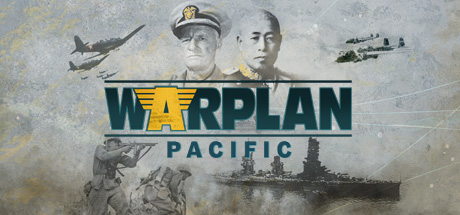“It was just like an old-time token shoot down home!”
Type: Single-player, Multiplayer
Genre: Turn-Based Strategy, Wargame
Developer: Kraken Studios
Publisher: Slitherine Ltd., Matrix Games
Release date: 29 April, 2021


Intro
Second verse, same as the first. I already made the joke back in my original WarPlan review that over half of Slitherine games are World War 2, and the joke I already made this joke in the subsequent Order of Battle review and that when you make a game about one theater in World War 2, you might as well release another game in the same engine in another theater to complete the set. So… here we are again. It’s WarPlan again, but now we’re in the Pacific.
Because it has been only a few months (since the review, the game was actually a bit over a year old by then) and most of the game is the same, I really do recommend going back to that review, since in this review, I’ll try to keep things short (for me) by focusing on the changes from the previous game.
Also note that the game is only on the Matrix website for now (the developer says that the profit sharing with Matrix/Slitherine is more generous), although it will be coming to Steam eventually.
Island Hopping
In the previous game, I found naval battles to be the least interesting part of the game, because it was by far the one that seemed the most on autopilot. You couldn’t attack directly, you just moved into the same area as the enemy (or moved in the general area the enemy might move), and hoped that the RNG would do what you wanted. I wound up sinking the whole Kriegsmarine by accident when I was trying to support Norway and the entire fleet sailed straight into mine and was sunk without anyone even informing me it had happened but a small note in the “last turn’s battle log” section of the menu I had to actively look up to notice.
WarPlan Pacific at least gives you the ability to directly attack an enemy navy, but the existing “interception” mechanics still mean that what you have to do is move your fleet directly next to the enemy fleet (unless you have carriers, in which case you have to move within 5 hexes, which is still close enough for interception by non-carriers), which gives the enemy fleet a chance to intercept you before you have a chance to spend your second of two whole operation points per turn to attack an enemy fleet next to you. This basically means that most naval battles you start by moving on your turn are actually battles where you are on the defense, because the enemy is the one that gets to intercept you and maybe even get an ambush, which increases the damage based on yet more RNG.
In spite of this, it’s rather important to have the chance to directly attack enemy fleets, since it would be basically impossible to sink carriers without carriers in your own fleets otherwise. Since the opponent isn’t likely to be dumb enough to just move up to your fleet when it’s stronger than theirs to let you intercept them, it’s frustrating that you need to spend half your movement getting right next to an enemy, and then spend the other half just doing the attack.
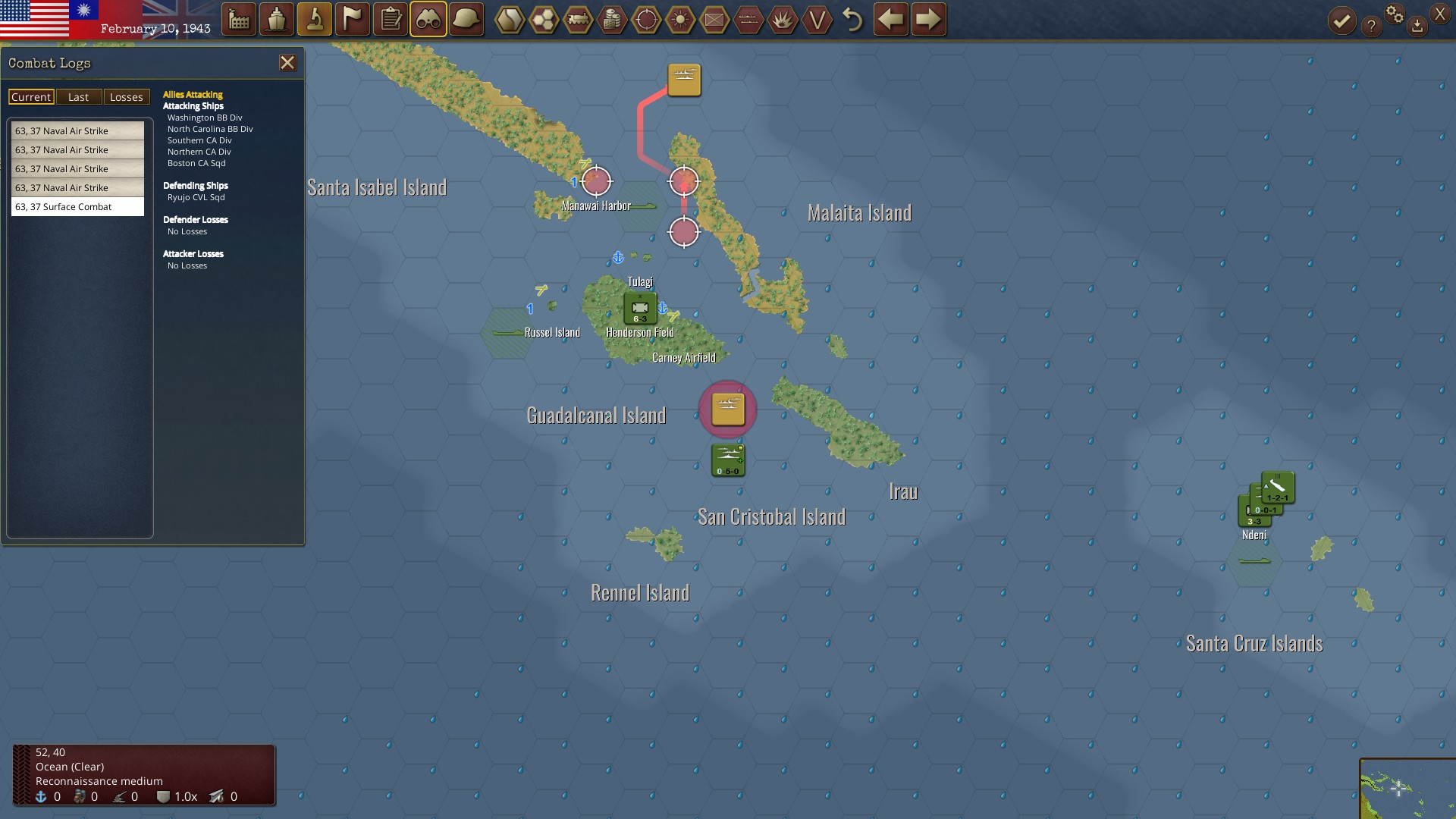
The supply system I lauded so much in the original WarPlan still exists in this game, but outside of continental Asia, it rarely gets to have the same impact it did in small islands than it did with the large continents with Main Supply and long railroads.
Instead, most armies are relying upon Port Supply, wherein the amount of troops that can be supplied is based upon what can be shipped into ports. Ports have numbers that indicate their size, and ports provide 20 port supply per port size. (Port size less than 5 also determines how many ships can be resupplied at once in that port.) Many small islands in this game have a port size of only 1, meaning that large corps or armies of 30 strength cannot ever be supplied on the island, and some units like bombers require 1.6 supply per unit of strength in their unit. In larger islands with multiple ports within supply range of one another, each port adds supply, meaning that each port you take allows for more units to be added to the island to take even more of that island.
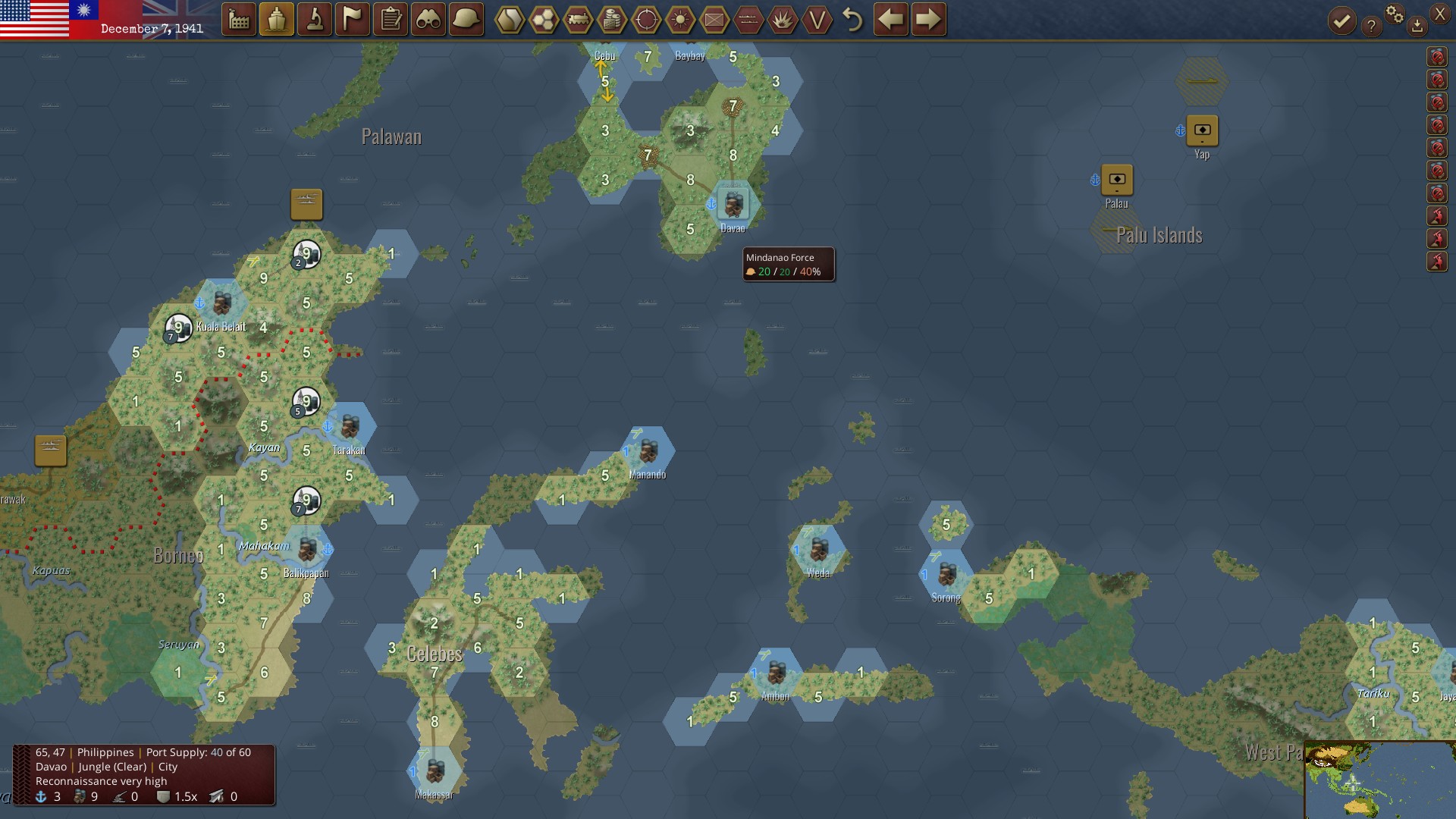
Amphibious assaults are a major focus of this game, but they also run headlong into the problem created by only allowing one land unit per hex on the map and pushing the enemy back often taking overwhelming numbers. Many islands are small, severely limiting the number of hexes you can attack from. Additionally, amphibious assaults inflict a significant penalty (-30%) to effectiveness, and effectiveness is a multiplier on your combat power. The enemy will have defensive positions, entrenchment, be at full effectiveness because they never move, and cannot be cut from supply to reduce their effectiveness unless it is one of the islands with special cutoff tiles. You can get naval or air support to help you, but these at best reduce enemy effectiveness while being severely inefficient while doing so, and therefore, what you really need is to swarm an enemy with many tokens from every side possible.
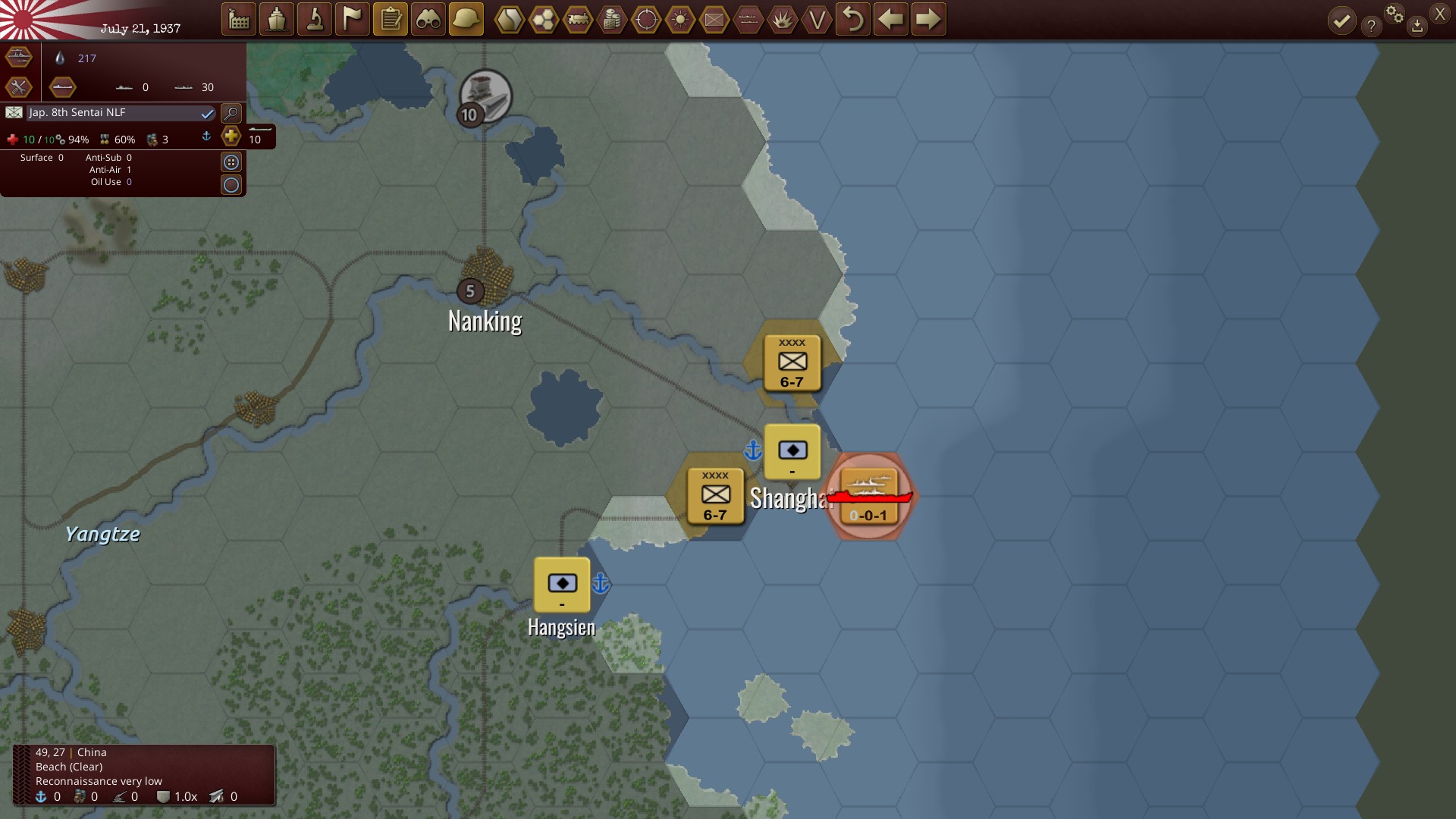
Marine units are notably unsuited to their primary purpose. (Which is a little less than ideal.) Most marines only come in 10 strength units (although in the main campaign, the US Marines come in 15 strength units, but not in the other campaigns). Garrisons can often come in 10 or 20 strength units. Marine units can often have better equipment, but not enough to make up for attacking an entrenched enemy that outnumbers them two-to-one with the advantage of being a defender while also being entrenched and having the marines suffer the 30% or so drop in effectiveness just from the landing itself. You already basically cannot win battles unless you have a 3:1 strength advantage, but you’re typically amphibious assaulting units that will be 1:3 against a marine unit on its own. You basically cannot use anything but your heaviest 30 strength army corps units (if not armored corps) if you hope to take most of these small islands with one unit, and a great many islands in the pacific require this because it’s vastly more difficult to wipe out port supply in this game than it was to isolate an island like Truk in the real World War 2. (It is, in fact, a major complaint I have that you cannot interdict enough supply to make units take attrition from being out of supply except for specially-marked islands, meaning cutting off naval supply like in Guadalcanal is impossible in this game.)
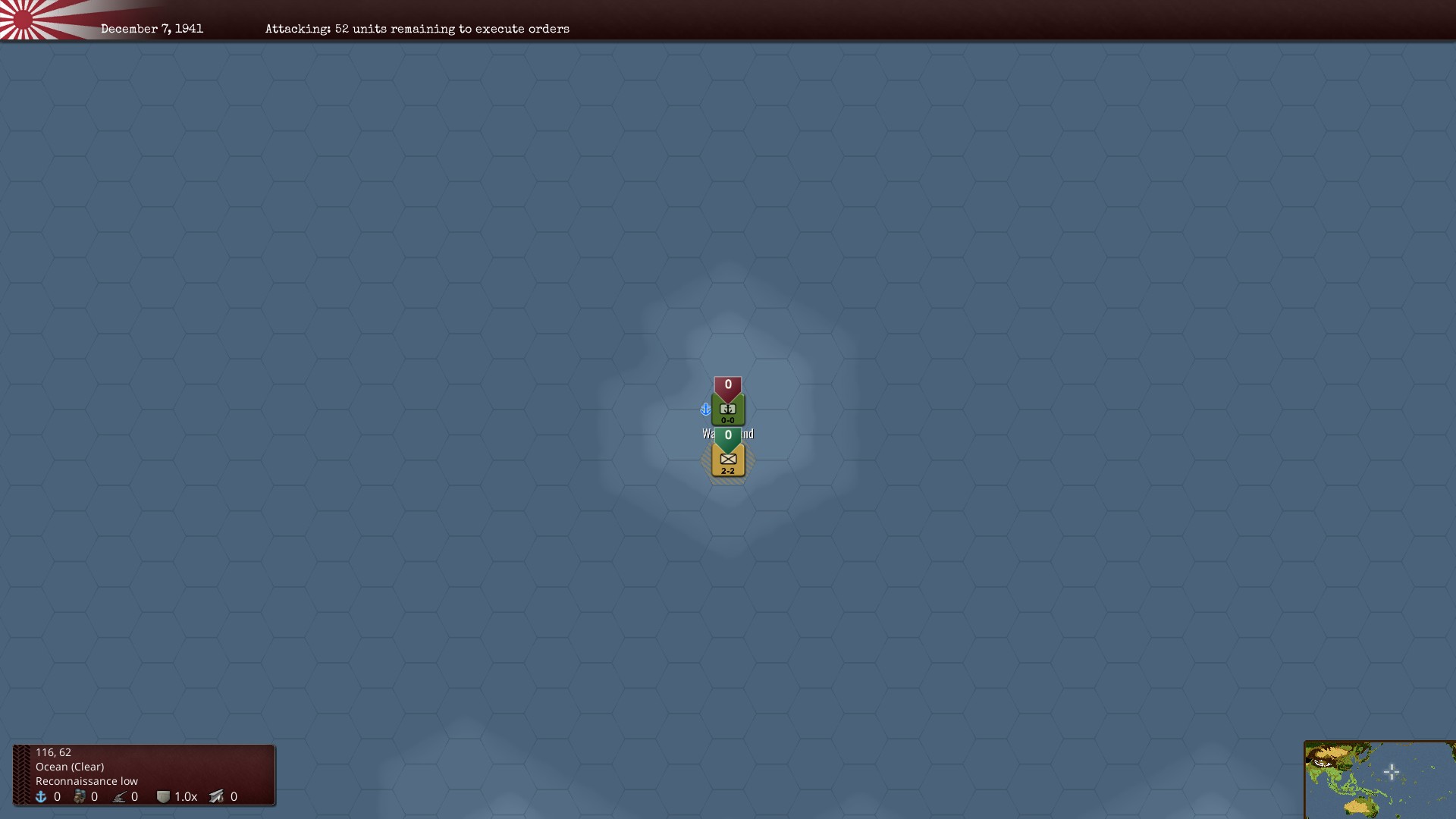
Instead, Marines seem to oddly have the ability to just walk to other islands that are only one hex away (in spite of intervening sea) without needing landing craft, but they can’t attack while doing so, and supply doesn’t follow their path.
Praise RNGesus and Pass the Supply Truck
I’ve said before that strategy and randomness are inherently in conflict. Strategy is your ability to plan what you are doing several steps in advance, and more than a small amount of randomness renders advance planning meaningless. This is especially true when the randomness applies after the player’s choice (such as dice rolls for success), rather than randomness that applies before player choice (such as drawing cards that have deterministic effects when played), since the latter allows for planning while forcing adaptation to changing unforeseeable circumstance while the former generally forces players to keep making the same choices until they succeed.
WarPlan was already fairly random, with how much the almost completely random retreat system could absolutely overturn your best-laid defensive plans and create a rout in spite of your own forces being superior to the enemy, or you could pound a defender with ten-to-one odds a dozen times and they still never give a crucial port up.
What changes with Pacific, however, is the much greater focus upon naval battles. Naval battles have no terrain effects and the units fly around the map at high speed. There’s basically nothing you can do but gob all your units together and hope for the best. (… Or just give up and savescum until you win, if playing single player.) The way that naval damage works in this game is that each naval unit has between 2 and 4 strength (hit points), while if a unit is hit, there are two additional rolls for “critical hits” that double the damage, taking it from 1 to up to 4 damage, instantly sinking a ship. This is randomness on top of randomness where you have extremely little meaningful choices besides whether you fight at all, which is a choice mostly made based upon how the previous few rounds of naval battles went, themselves.
During the Solomons scenario, for example, I had to reload an earlier save when I found out that an amphibious assault I had performed couldn’t possibly succeed because of a bug I mention down in the bugs section. When reloading the save that I had dropped before a dangerous fight, I noticed I got a much different result this second time around…
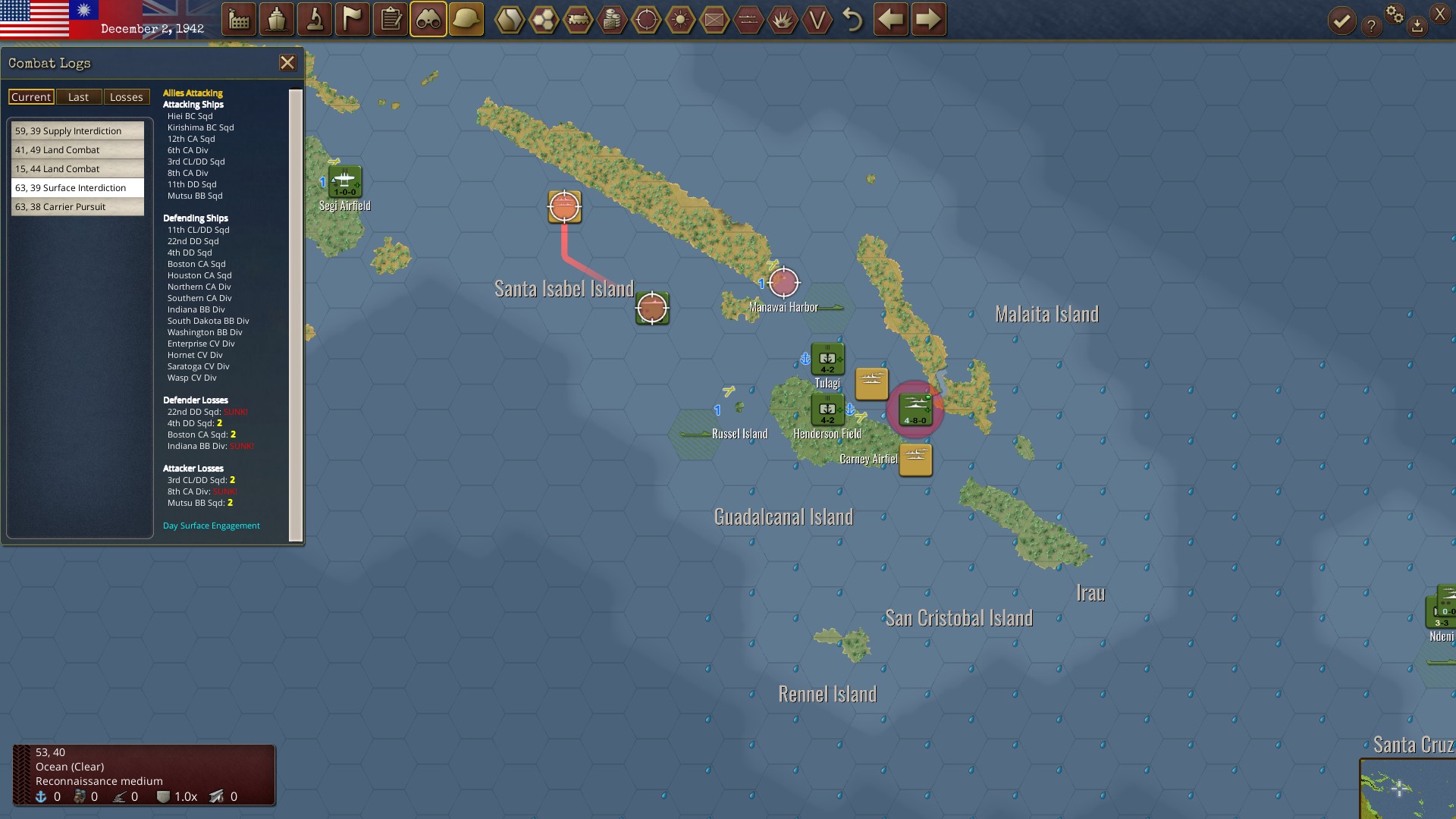
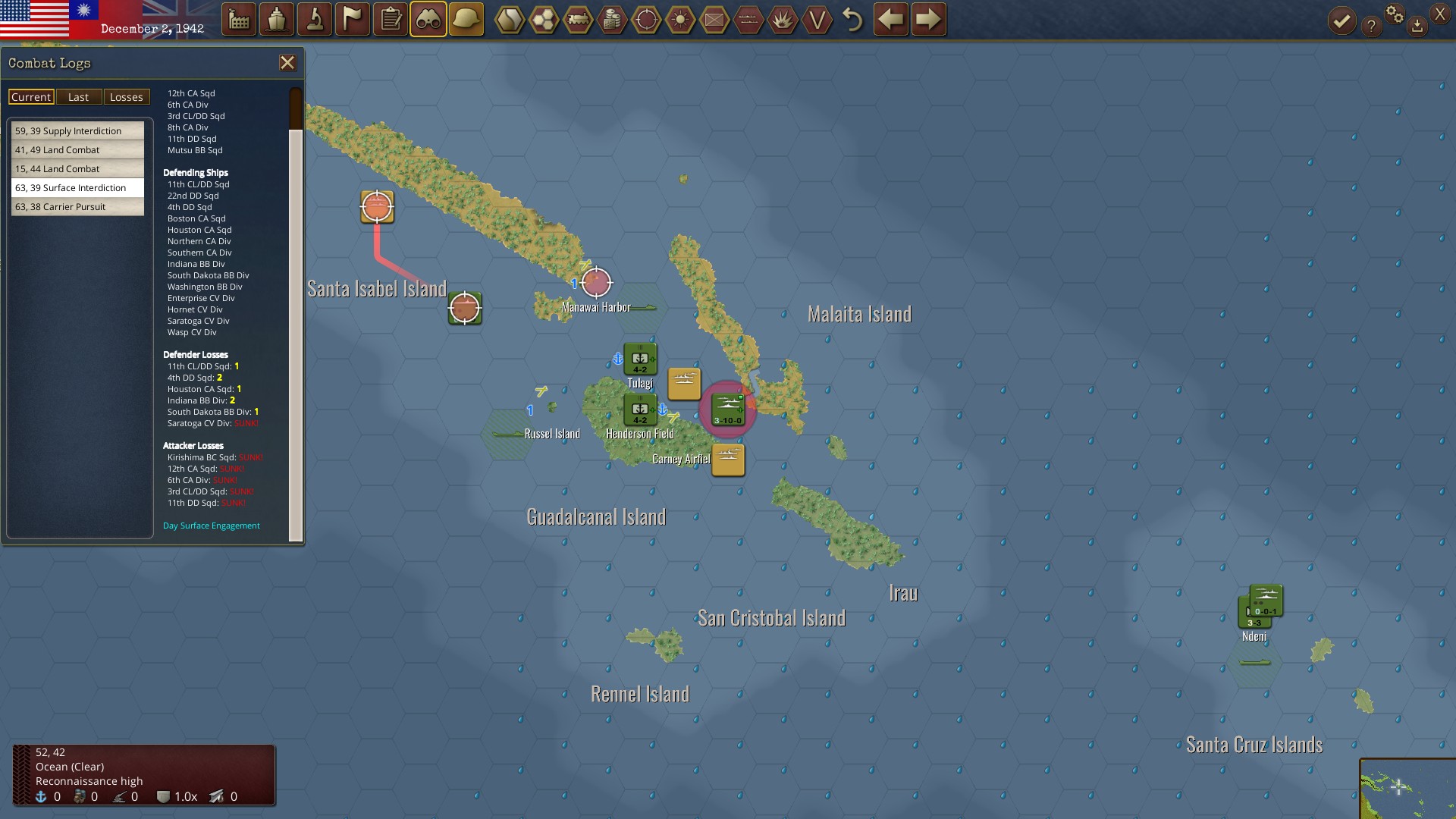
After reloading because of the failed landings, where things were quite tense for me, the game was a total cakewalk because suddenly I had much less Japanese opposition while trying to advance, and I could free up more ships to assist in landings with naval bombardment.
This amusingly even extends to Pearl Harbor. Playing the Japanese start, I found that it’s not even set which ships sink at Pearl Harbor (although Arizona always seems to sink first), and it’s possible to absolutely flub the initial bombing without sinking anything.
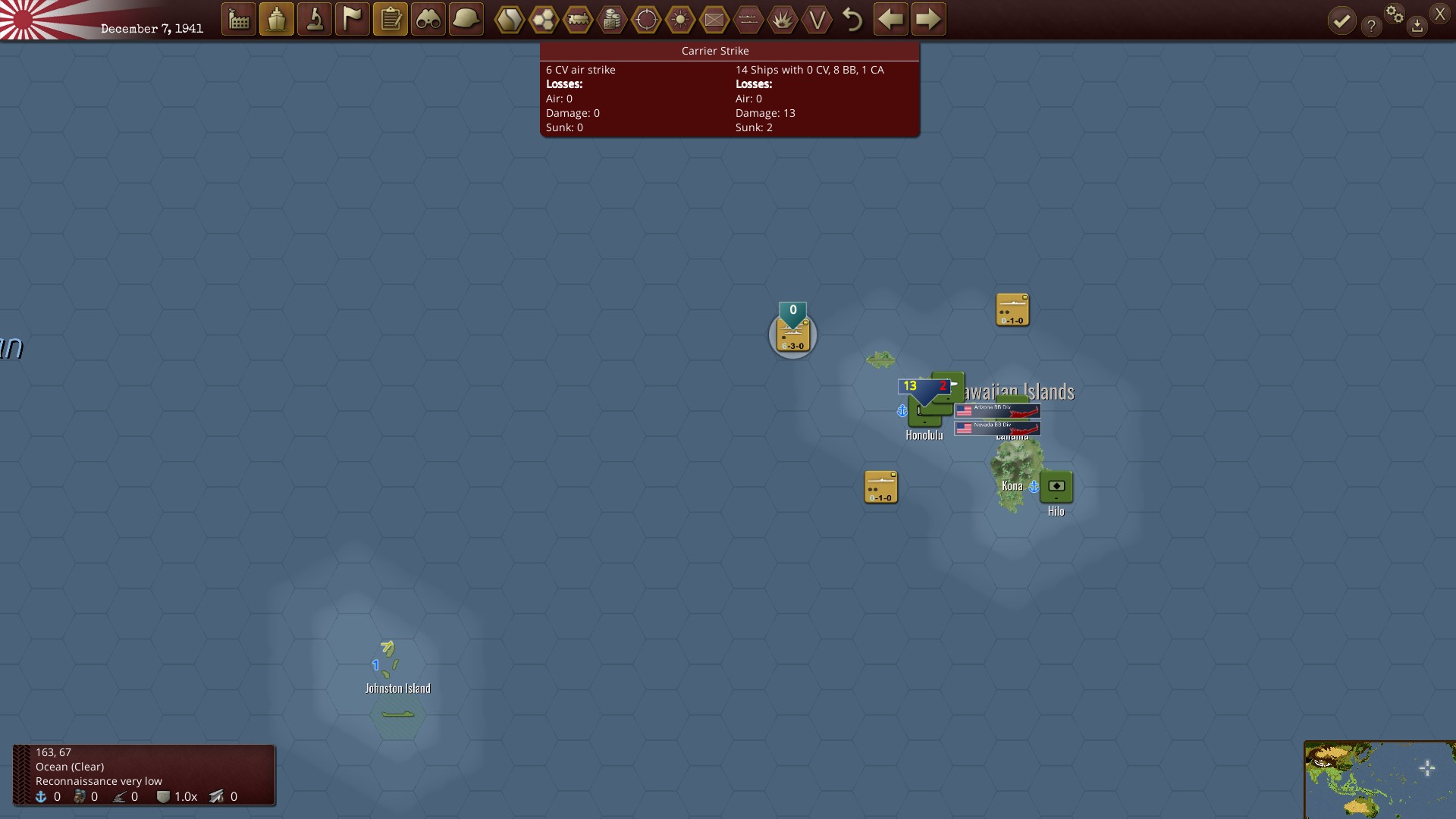
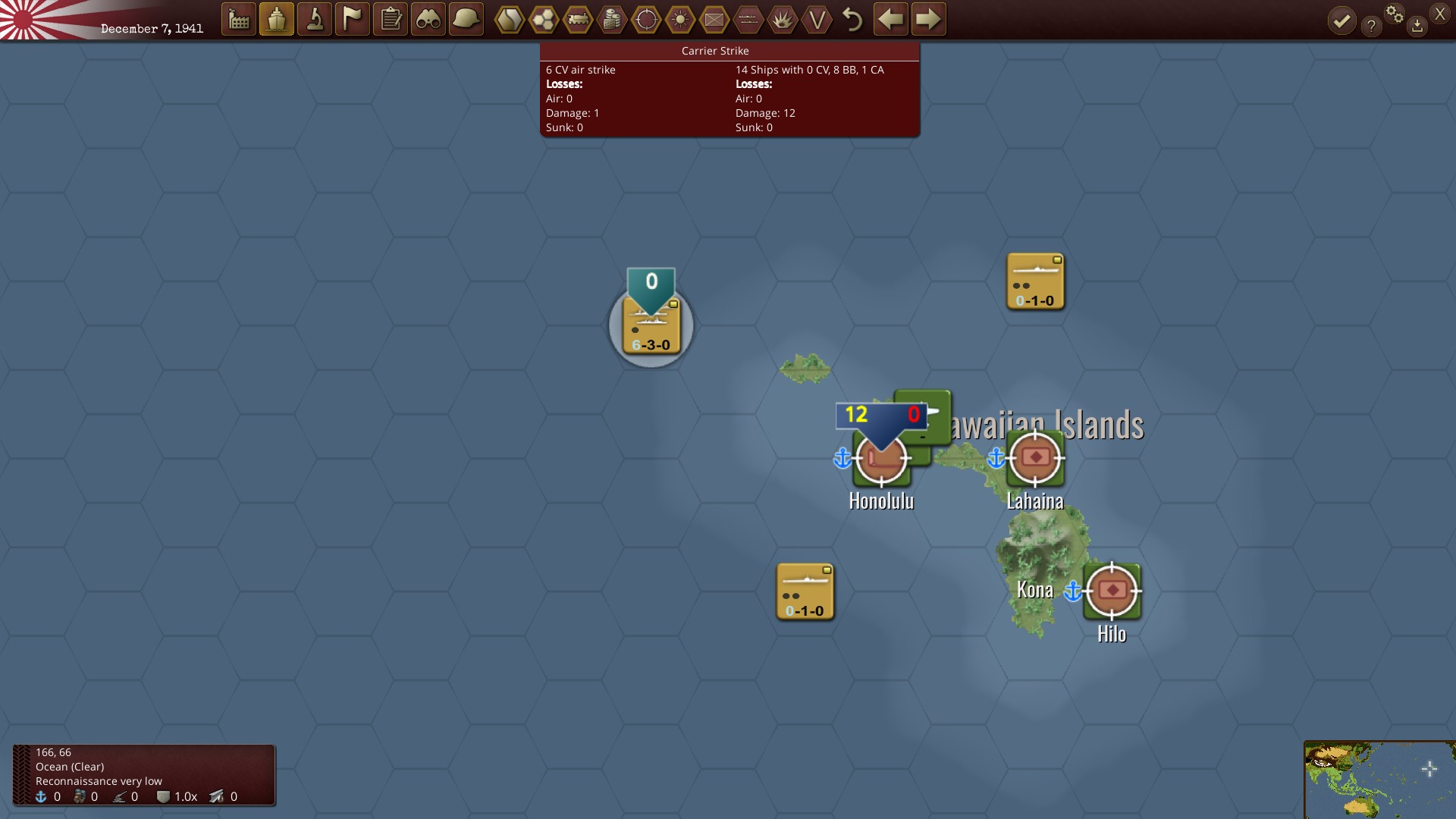
Many strategy games start just after Pearl Harbor just to make sure the balance of power isn’t upset in ways that something like the Japanese not knocking out any battleships at Pearl Harbor one game while destroying most of the fleet in another would upset the way that the war went forwards from a point before any player choices on either side have even been made.
It’s also worth noting that building a new ship takes a huge period of time (although not quite as long as the real ships took), as much as almost two whole years for battleships, meaning sinkings are extremely notable losses, yet how fast ships are repaired is based upon how much you put into the reinforcement pool in the build menu. (This is set low by default, but you can jack up reinforcement to 300 or whatever. I have no idea what that’s 300 of, but it’s not costing me 300 production to set it to 300, and setting it to 300 means all my units are repaired basically to full every round, so anything besides sinking is barely worth noticing, even though actual damage to ships could take as much as a year to repair in many cases.)
Likewise, it’s worth comparing this to the land battles, where you can outnumber an enemy 8 to 1 and still deal 0 damage to them, and even if you deal damage, it repairs by the next turn, anyway. (I have seen air units actually inflict damage on land units about a grand total of 6 times in this game.) Units will easily shatter, however because they have an absurd chance to retreat even while outnumbering the enemy, and units that can’t find a path to retreat – even if one exists – just get deleted. This is by far the primary way to actually accomplish things on land, so surrounding enemy units is key.
Campaigns
Unlike the original WarPlan, which featured several start dates to a main campaign spaced roughly a year apart each, plus a single North African Campaign that was of a smaller scale, WarPlan Pacific features only two start dates of the main campaign and multiple smaller campaigns.
I’ll work my way up from smallest to largest.
Okinawa is largely a disappointment. The historic battle was notable for the defense being hopeless, but the defenders holding out tenaciously and for much longer than anyone expected. This campaign, at least for me, made it a total cakewalk. It was here I discovered that the game never stops until you hit the historic end date set forth, because I eliminated all resistance in half the time the game gave me, but I had to just sit there end-turning until the game allowed me to win.
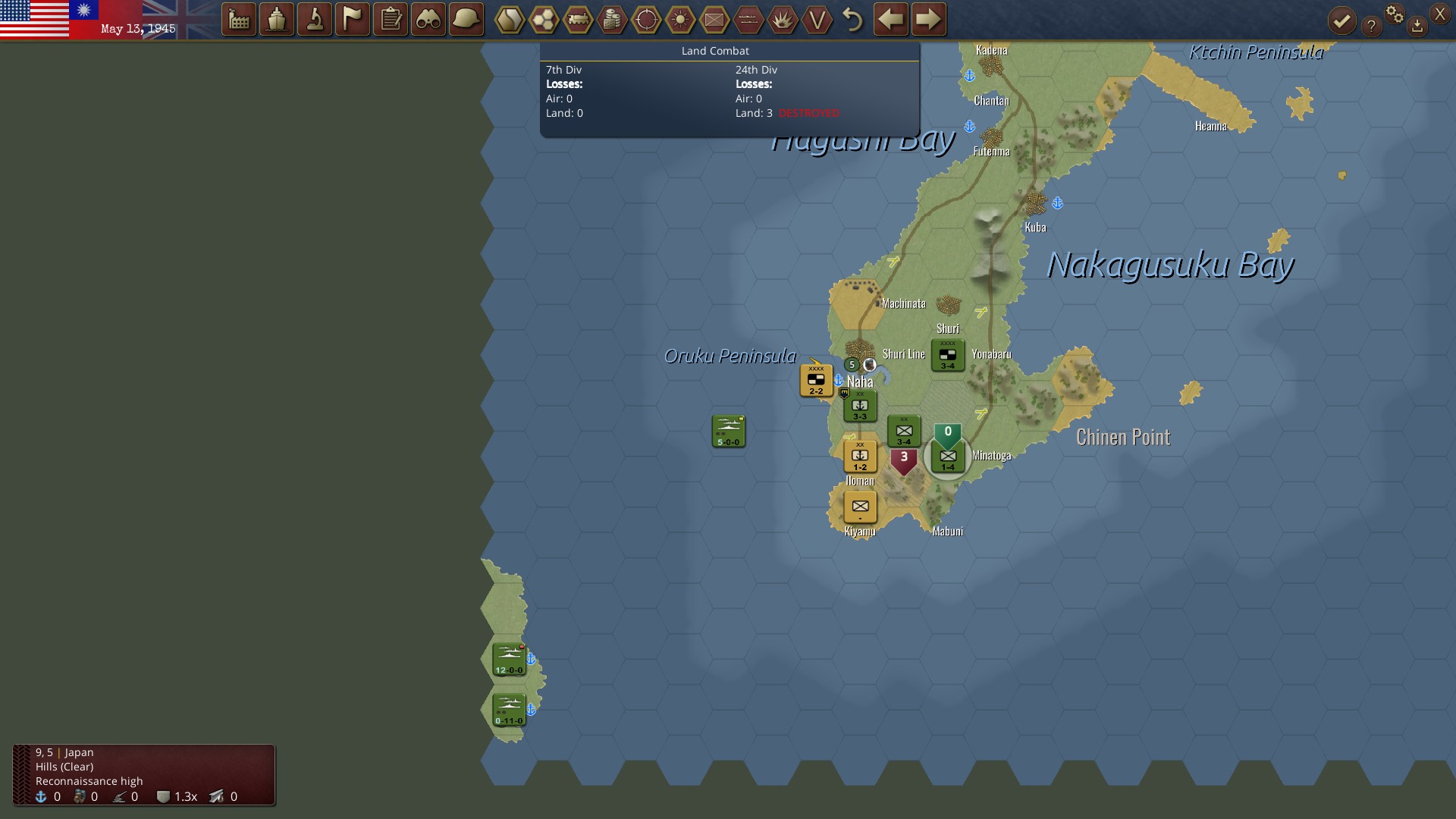
This scenario is easy for the Americans, and pointless to play as the Japanese. Defense in this game is not terribly interesting at the best of times, as all you can really do is try to find the locations that allow the least flanking and just sit there and hope the RNG favors you, but it’s especially terrible here, since this game has significant problems with scales smaller than the one it was designed for making the game even more random than it already was, and this scenario in particular basically meaning there’s little reason to ever move the Japanese units at all.
It’s notable this scenario does not say it’s balanced for multiplayer. The thing is, it’s not balanced for singleplayer, either. It doesn’t even work for getting your feet wet with combat, although I suppose it is a way to learn how the new naval bombardment support system works…
China 1937 is the scenario most like the original WarPlan, in that it’s mostly land-based, dependent upon rail and the standard logistics rather than port supply, has partisans cutting those railways, and features the dreaded “Temperate” weather zone for most of the area. Sadly, it seems to highlight the most annoying aspects of the original WarPlan rather than the best, and this campaign featured the most frustrating bugs and the return of the unrealistic weather issues. The Chinese, for their part, will almost never attack unless you completely allow your armies to drop to 10% effectiveness.
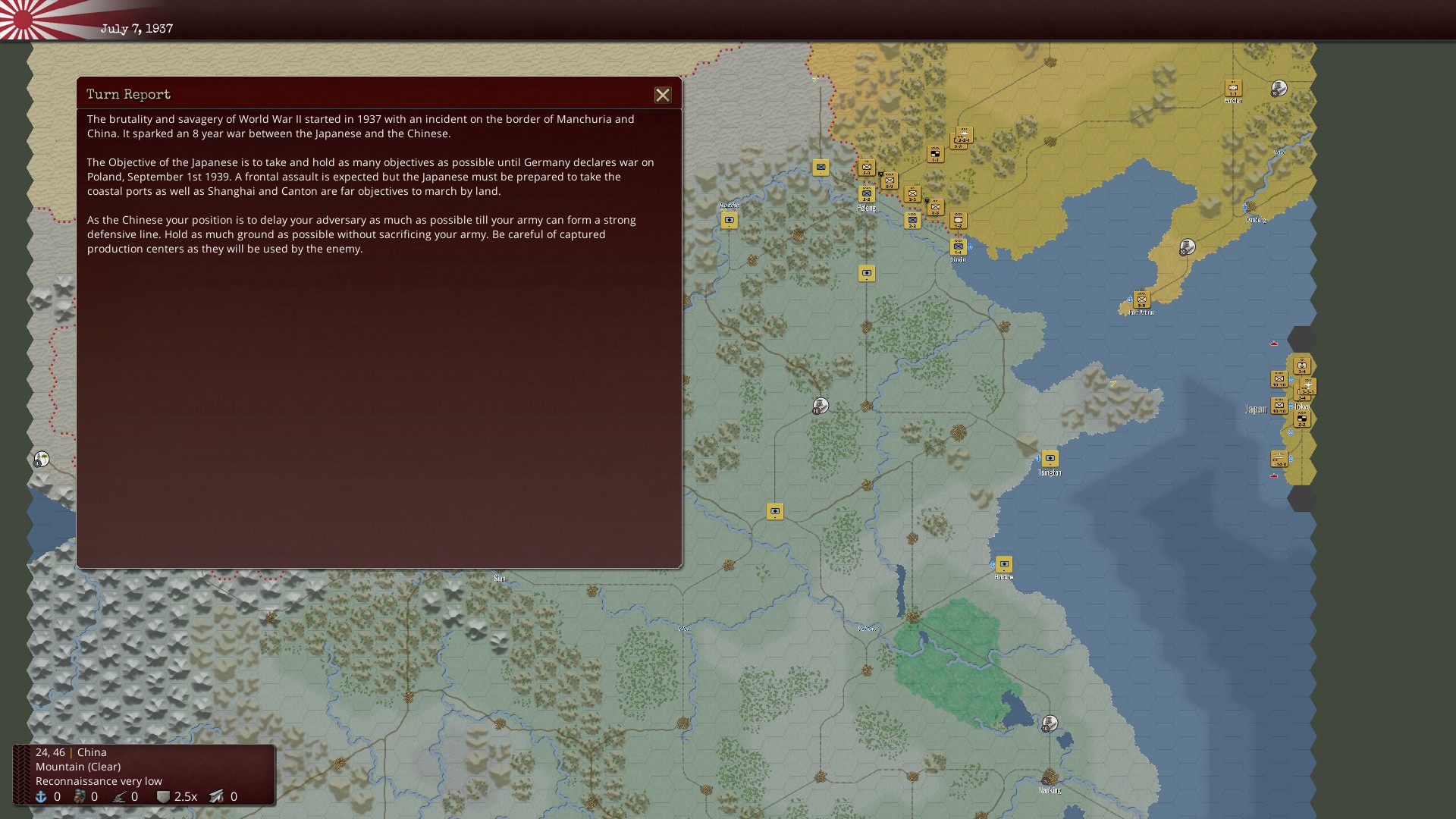
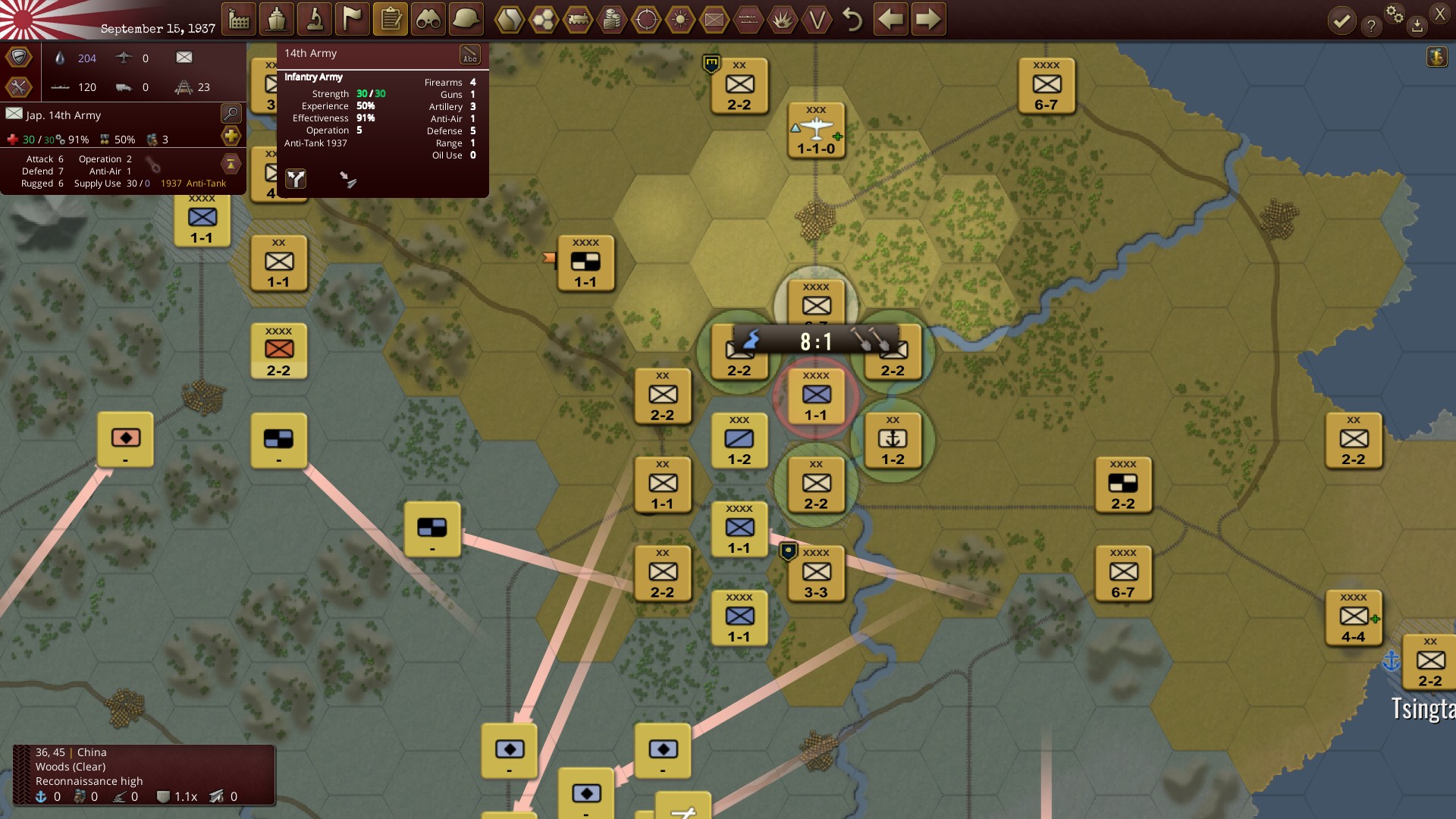
Solomons 1942 is definitely the best scenario besides the main campaign. While it does feature a larger area, and allows the Allies to reclaim New Guinea and New Britain as well, this is functionally the “Gudalcanal Campaign” campaign, and perfectly showcases how, while Midway gets more press, the place that the United States learned how to Navy and the IJN was truly defeated was in the waters of Ironbottom Sound. This mission starts off just after Midway with the US forces ready to land upon an unprepared Guadalcanal, with Japan having major naval forces sail in soon after the first landings. This sets off an absolutely brutal battle of attrition that historically was a stalemate for six months before the United States won through sheer capacity to sustain said attrition better than the Japanese.
Considering the way that naval battles in this game work, this is largely how things go, although the RNG can, again, wildly tip the scales especially towards an early decisive American victory. The more lucky you get early on, the more ships you can bring back to fight again next month, which tips the scales more and more in your favor with every engagement. Unlike the main campaign, there’s no diversion to other fronts, it’s all ships in two to five giant stacks just whaling on each other over and over until only one remains.
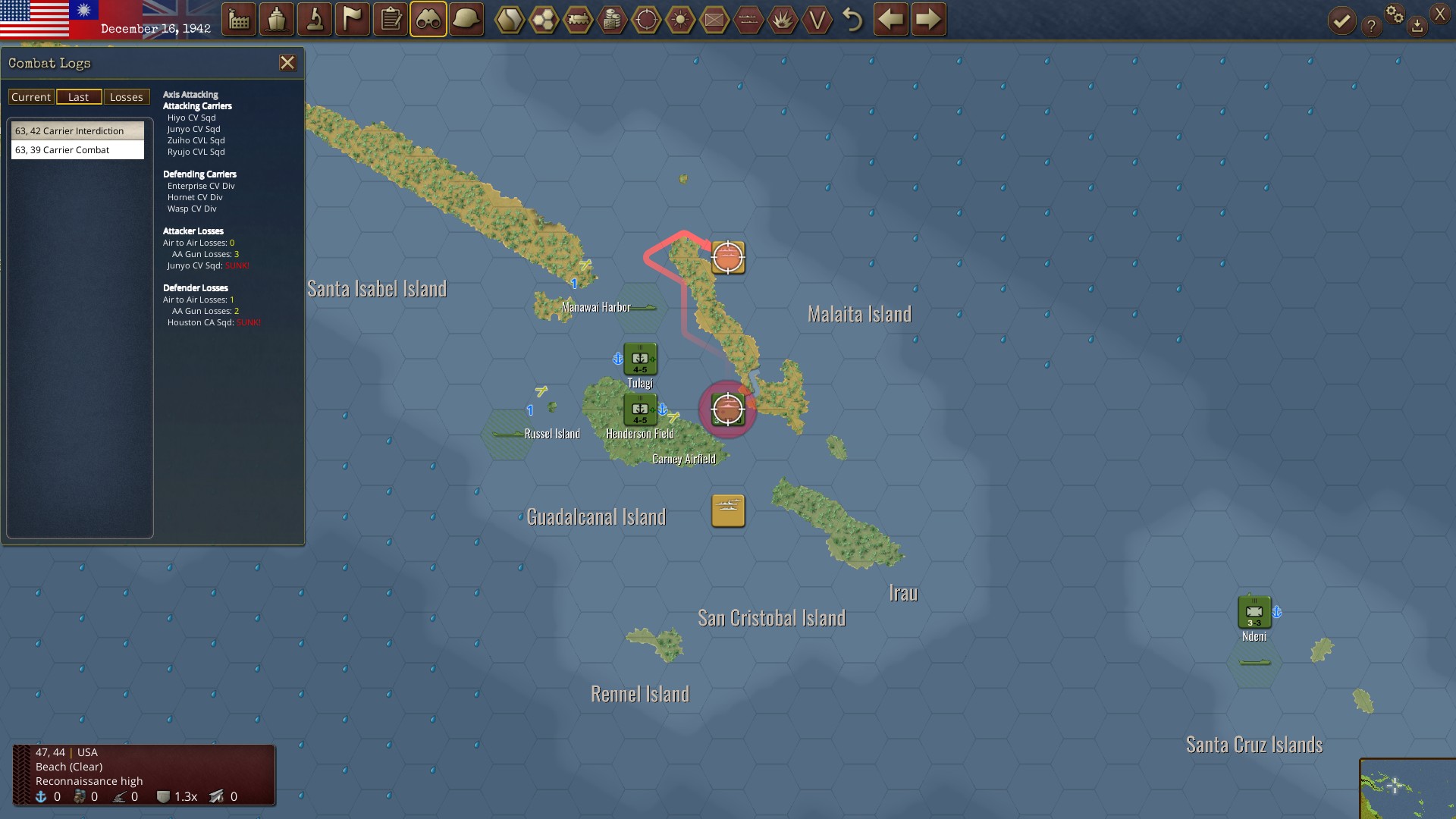
The final two campaigns are the main, full Pacific campaigns. Unlike the previous game where there were four starting times, there is a Pearl Harbor start and a Coral Sea start. The latter says it exists to “skip straight to the carrier battles”, but this is notably also skipping basically all the parts of the war where Japan was winning and nobody could do anything about it. The positions in 1941 are designed to be absolutely hopeless, and playing as the Allies (which the game recommends when playing singleplayer expressly because the AI doesn’t manage the island hopping campaigns well at all) means your first turn consists of blurs of units being destroyed for about 5 minutes before you can even start to make sense of a massive map and how screwed you are in nearly every corner of it. (The developer notably making the non-Japanese units at the start of the war have 10% effectiveness, meaning they have normal combat power, but are just temporarily rendered incapable of defending themselves rather than being permanently gimped because they’re from a nation that historically lost, which is notably exactly what I suggested in the review of the last game.)
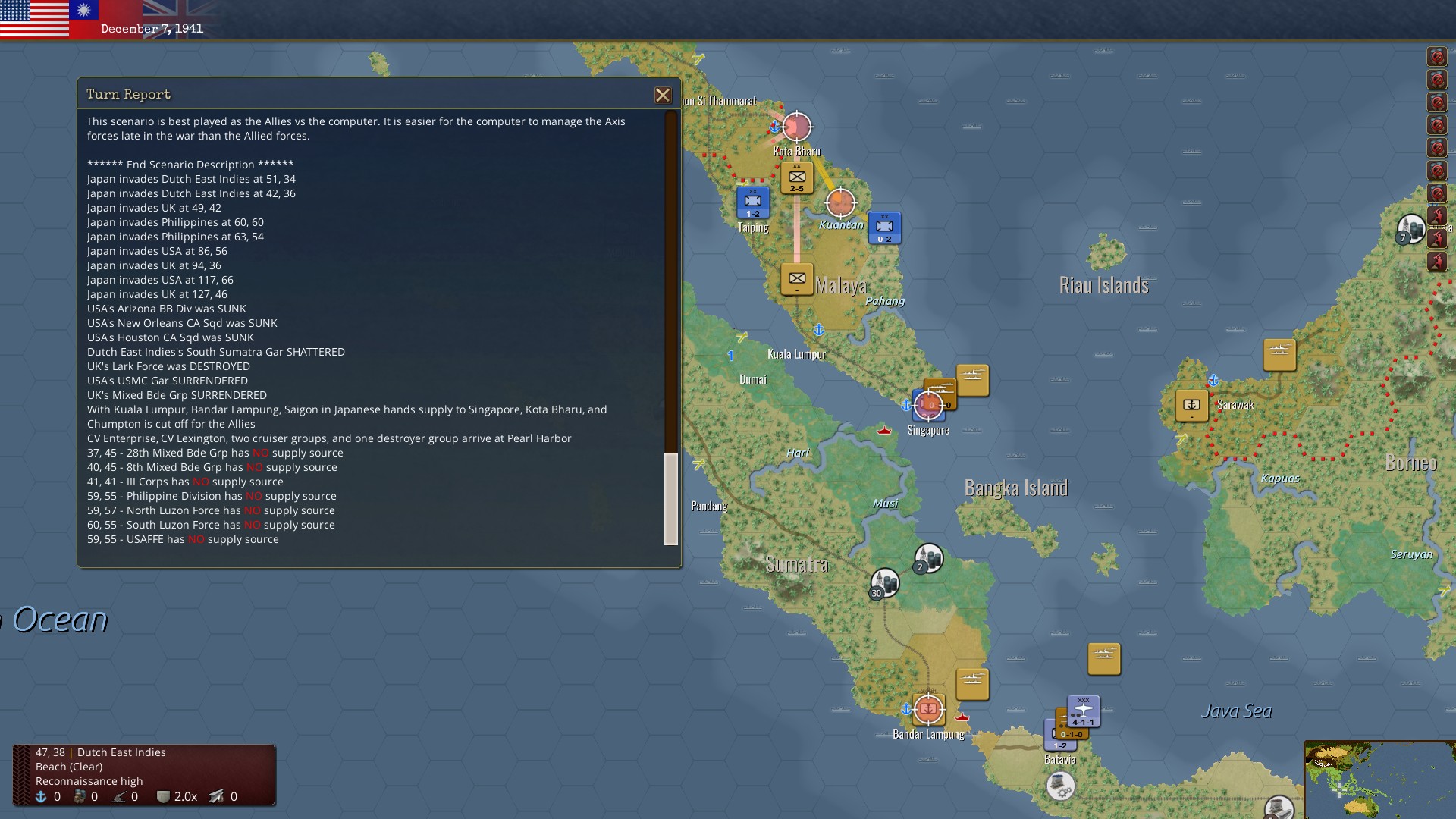
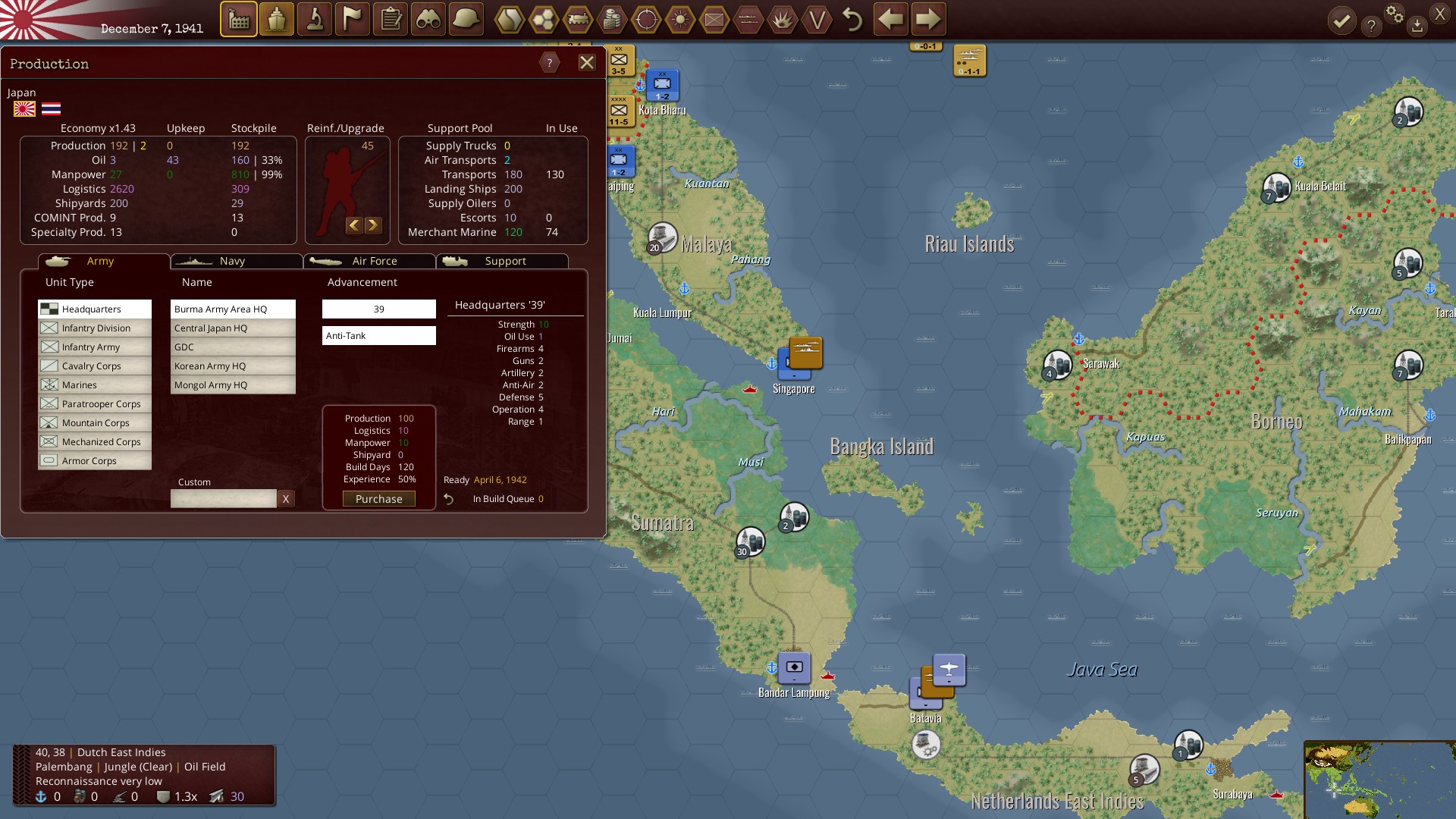
The AI
One of the things that the developer mentioned being the hardest part of this game being was making a naval AI that had any idea what it was doing. Anything involving an amphibious assault tends to be a nightmare when trying to script an AI in general, as experiences like the ones I’ve had with the likes of Crusader Kings can attest. (I have played Muslims fighting off crusades where the crusaders vastly outnumbered my forces, but where the Christians forces trickle in over the course of 2-3 years, often starving because they literally marched all the way from Spain to Jerusalem, only to never bother forming up into a stack that could oppose my armies until after reaching the Holy Land… and it’s not like I’m dumb enough to let them do that. The few units that are levied on ports sail to Jerusalem, but the rest walk the whole continent, and starve most of the way.)
Whereas land units generally just follow the flow of the terrain and gradually wash into the enemy army on its way to the objectives set for it, an amphibious assault takes understanding what your target is, what forces it requires to take it, having or ordering the landing craft it takes to make the landing, finding those forces from within your troops that can be spared to this operation, sending them to a port to get onto a ship, forming up a fleet to support the landing craft, and then moving a coordinated stack of units to perform multiple landings around your target so as to overwhelm the enemy before they can respond. The computer is completely awful at doing this dynamically, which means that most such amphibious assaults, especially the Norway invasion in the original WarPlan are basically scripted with units earmarked for that operation at the start of the game. This basically means that the AI cannot understand how to react to take advantage of any holes you leave by not garrisoning your ports, among other things.
The limitations of the AI are most apparent in campaigns like the Solomons one, where the Japanese navy will keep sending its fleet at Guadalcanal even as you’ve moved well past Guadalcanal and even already taken Rabaul. The navy keeps attacking to support landing forces to retake Guadalcanal that don’t exist. The Japanese side never even tried to land any infantry to contest anything I was taking. In New Guinea, the Japanese just sat around waiting for me to surround and destroy their forces with reinforcements, because they sure weren’t going to attack Port Moresby with the under-strength units they started with and they had no inclinations to reinforce them.
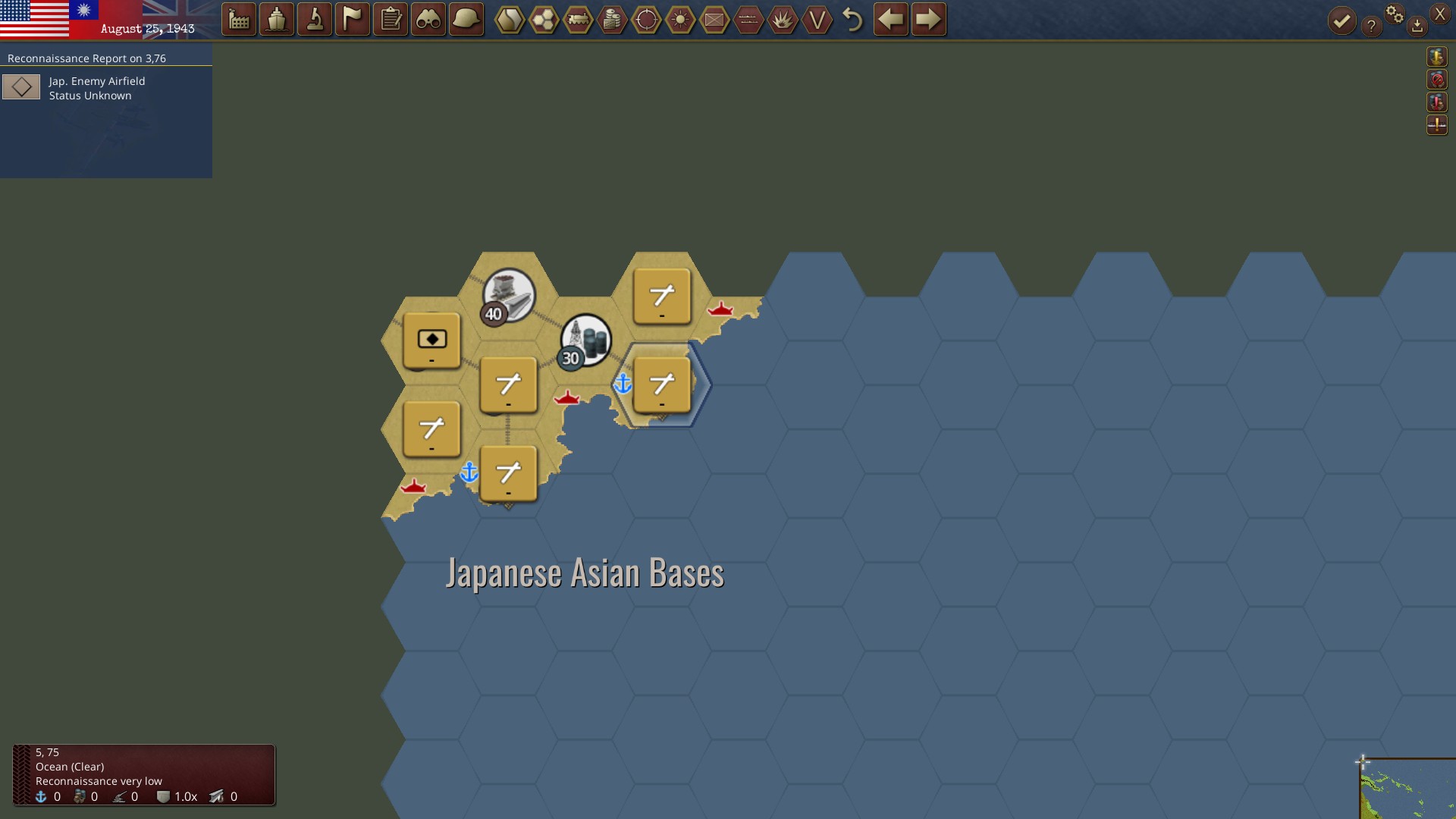
The most absurd part is how they keep sending ships to blockade Guadalcanal even when it’s hopeless. Yamato and Nagato are the last ships to arrive in the theater, in August of 1943, but by that point, I had already taken every victory point, and my fleet had 7 carriers and 5 battleships sitting in Rabaul, but Yamato and Nagato went out unsupported to contest Guadalcanal, anyway, because they have no programming to do anything but send their ships to Guadalcanal over and over.
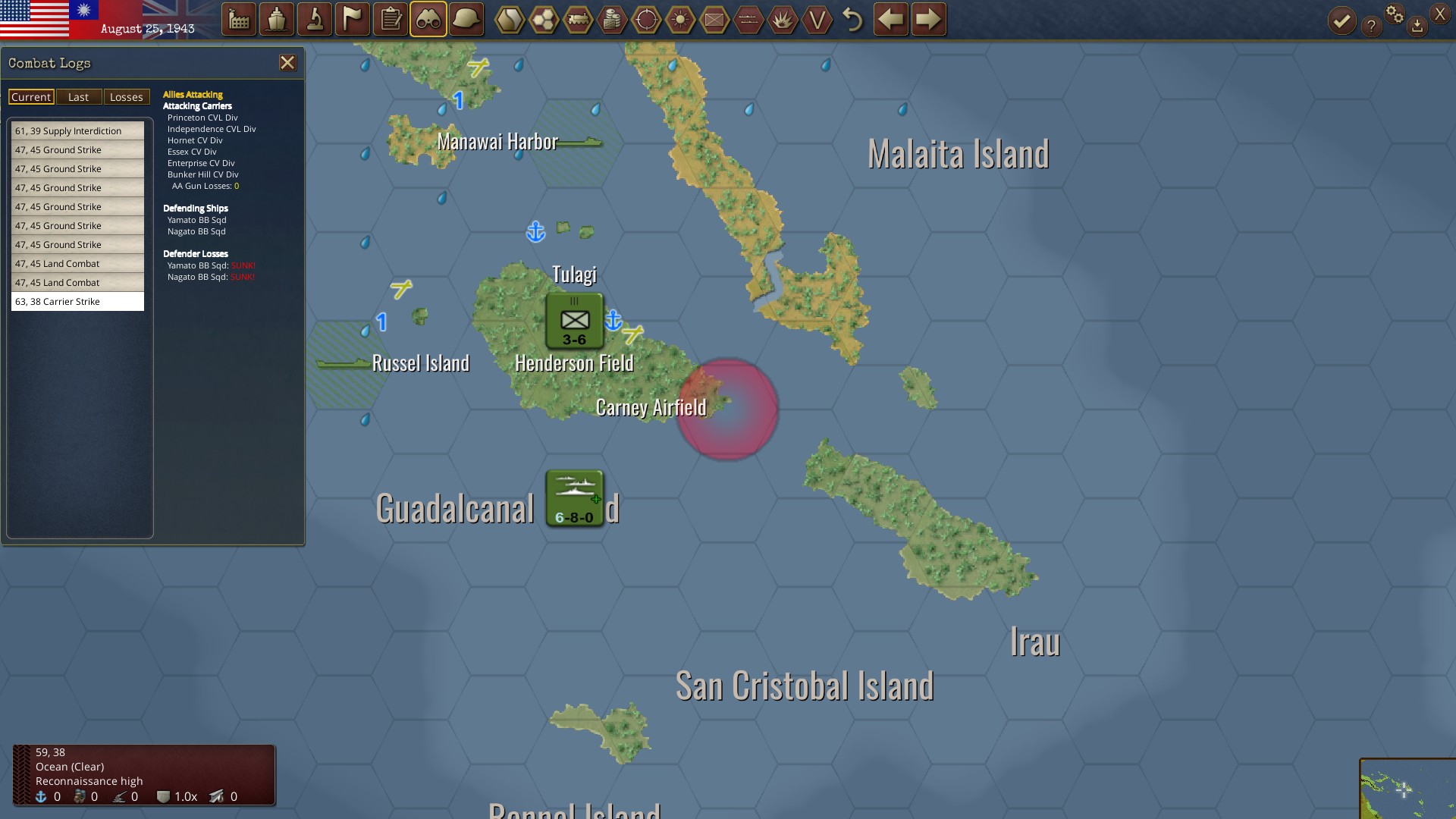
There is also notably an option at the start of campaigns about whether you allow for “Random” or “Historic” AI, and the game is already really, really bad at handling anything going differently from the historical outcome of the war (which is rather odd considering how much RNG can completely overturn historical events), and “Historic” AI makes this crippling weakness even more dire. The AI just does not recognize what you’re doing if you simply go around some of the objectives and bypass their defenses. (In fact, the main campaign recommends playing as the Americans in singleplayer explicitly because the AI is not equipped to manage the multiple amphibious assaults winning the game requires.)
Comint
In order to represent the general wild success that the US had in breaking the Japanese cryptography (which was much weaker and vastly less frequently cycled than the notorious Enigma that Germany used), a new COMINT feature was added. The problem is that land units are already always visible, just without their strength revealed, even though you can typically guess. You deal less damage to units you have poor intelligence on, but since you generally only want to attack units you can move next to in the first place, and that reveals all information, this is generally not relevant. Naval units, however, are now invisible unless you have intelligence on them, giving you some reason to care about this system.
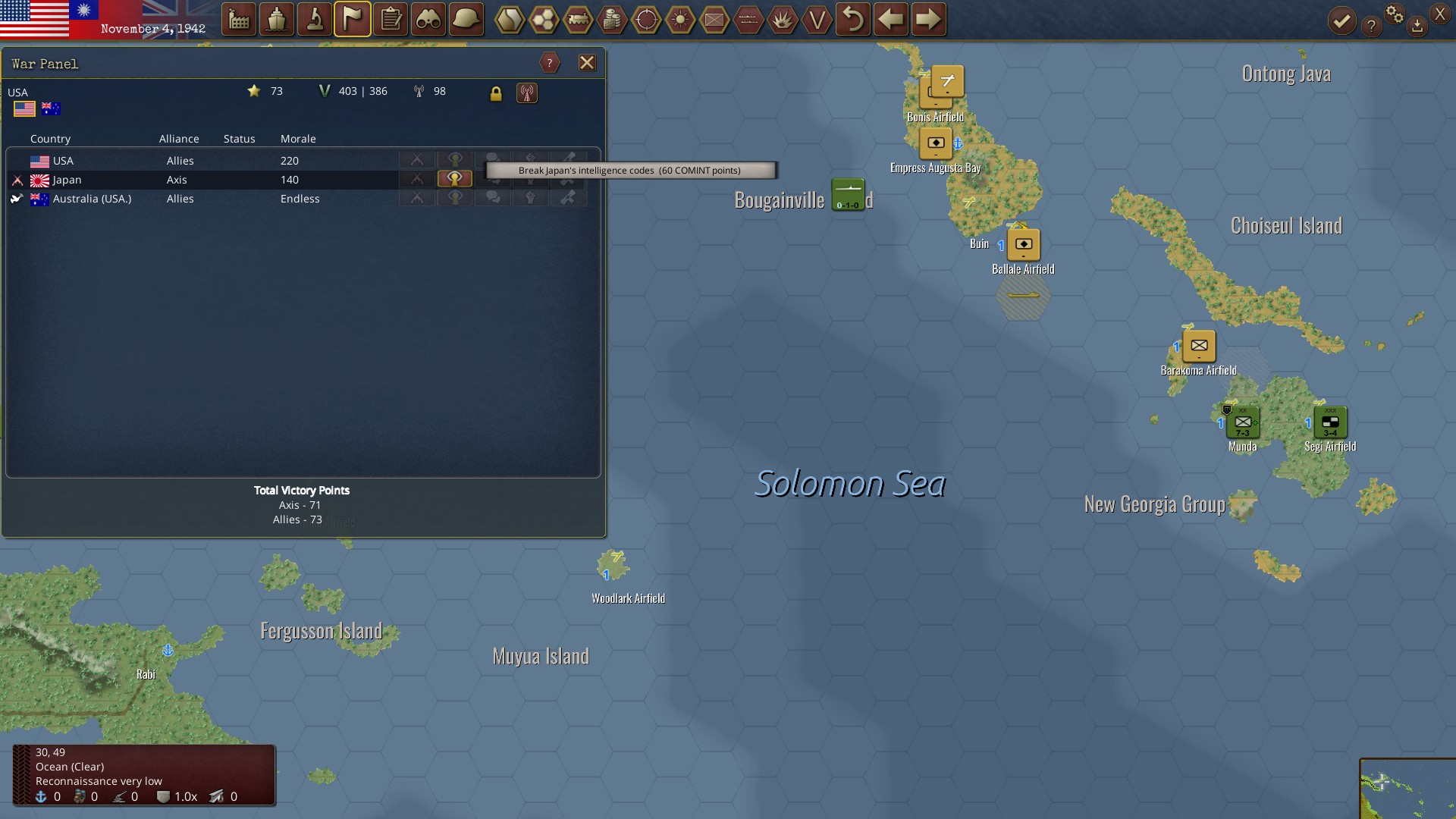
Trying to break codes costs 60 COMINT points, while changing your own codes costs 120 COMINT points. Note “trying”, this is yet another blind roll of the RNG, and I cannot stress enough how much this is basically begging those in singleplayer to savescum until it works because this takes several months of COMINT points to do once and it can result in absolutely bupkis based purely on a die roll. Because making everything random is what strategy gaming is all about!
Breaking codes means that you can see slightly more information about enemy units slightly further away, or in the case of naval units, can spot enemy naval units further from the coast.
There is also a Communications Intelligence Unit, but while it does reveal full intelligence on a medium-sized area, it does so for only one turn and is therefore nowhere near worth the price. While it could hypothetically reveal a fleet you could then attack, you’d only find an invisible fleet in the whole ocean with a limited-range ability through savescumming up a storm, and you can do that by just blindly shoving fleets around, anyway. This is even before you consider that you have to purchase it at least a month ahead of when you want to use it, meaning you have to not only be in the incredibly rare situation where this function would be useful at all, you have to predict it several turns ahead of time. No thanks.
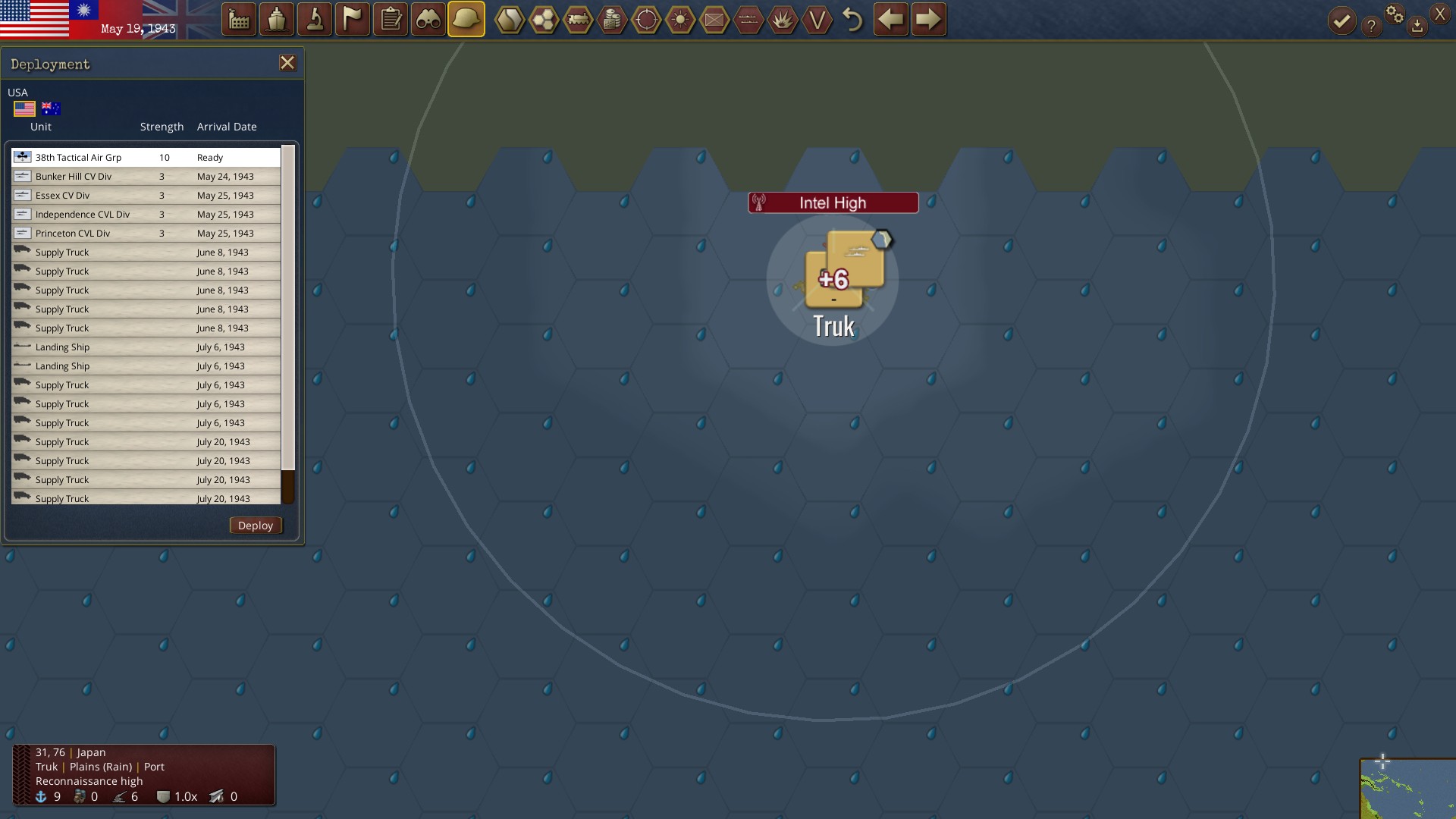
Weather Woes
Once again, by far the most frustrating and unnatural part of WarPlan is the weather system.
Weather in this game does not play out like most strategy games. There are massive “weather zones” that cover whole continents so that if it is sunny, it is sunny for the whole continent for the whole 2-week period of a turn, and if it snows, it snows for the whole continent, typically for several months at a time. The weather tables for this game are also absurdly unrealistic, with it having a 100% chance for clear weather in the dreaded “Temperate” weather zone that constitutes nearly all of Europe, North America, and Asia during the four summer months, but having a 0% chance four four months of the year and minimal chances during three of the remaining four (because of course, people never see the sun in most parts of the globe for most of the year). Don’t believe me, because I wasn’t playing the Steam version this time, I noticed the extra manual files this time:

This is such a problem because weather has an outsized impact upon land and air combat in the game. Non-clear weather dramatically reduces the effectiveness of armies, to the point where all combat basically has to stop for at least 8 months out of the year to wait for the dreaded European Spring to pass. Effectiveness is lost constantly passively, at a rate you cannot regain it passively past around 70%, and effectiveness costs of simple things like moving, much less combat, are multiplied.
I can kind of see what they were going for with this unrealistic system, where it rains all winter to represent it just being generally harder to fight in the winter, but weather is far, far too much of an impediment and non-clear weather is far too common. A better system wouldn’t necessarily involve continent-wide weather, or different weather per hex like most games have, but possibly something like a continent-wide “chance of rain” where some actions are impaired by bad weather as you move rather than all movement being impaired. Again, this isn’t the “Russian Winter” zone, which is worse (and historically had as much to do with the failure of Germany to plan ahead as the actual severity of the weather), but most of continental Northern Hemisphere. Never mind preventing combat in the winter, again, this prevents all combat in the spring and fall! This is in addition to the problem of your 5-operation-point infantry units that normally can move 5 hexes in clear terrain suddenly moving only 2 or even 1 in heavy rain. This could be mitigated by just using the computer’s ability to handle decimal places and make rain only cost 1.3 operation points to move instead of rounding up to two and cutting movement by 60% as soon as there’s a light drizzle. It is extremely frustrating in a mission like the 1937 China campaign to have only 1.5 years to complete your objectives… and then 0.9 of those years wind up stolen by weather when the weather absolutely does not behave like this. (And in the original WarPlan, Germany basically failed to conquer France in my game specifically because the weather kept ruining their assaults.)
Fortunately, at least, unlike the original WarPlan, the game isn’t played nearly entirely in the absurdly deterministic “Temperate” weather region.
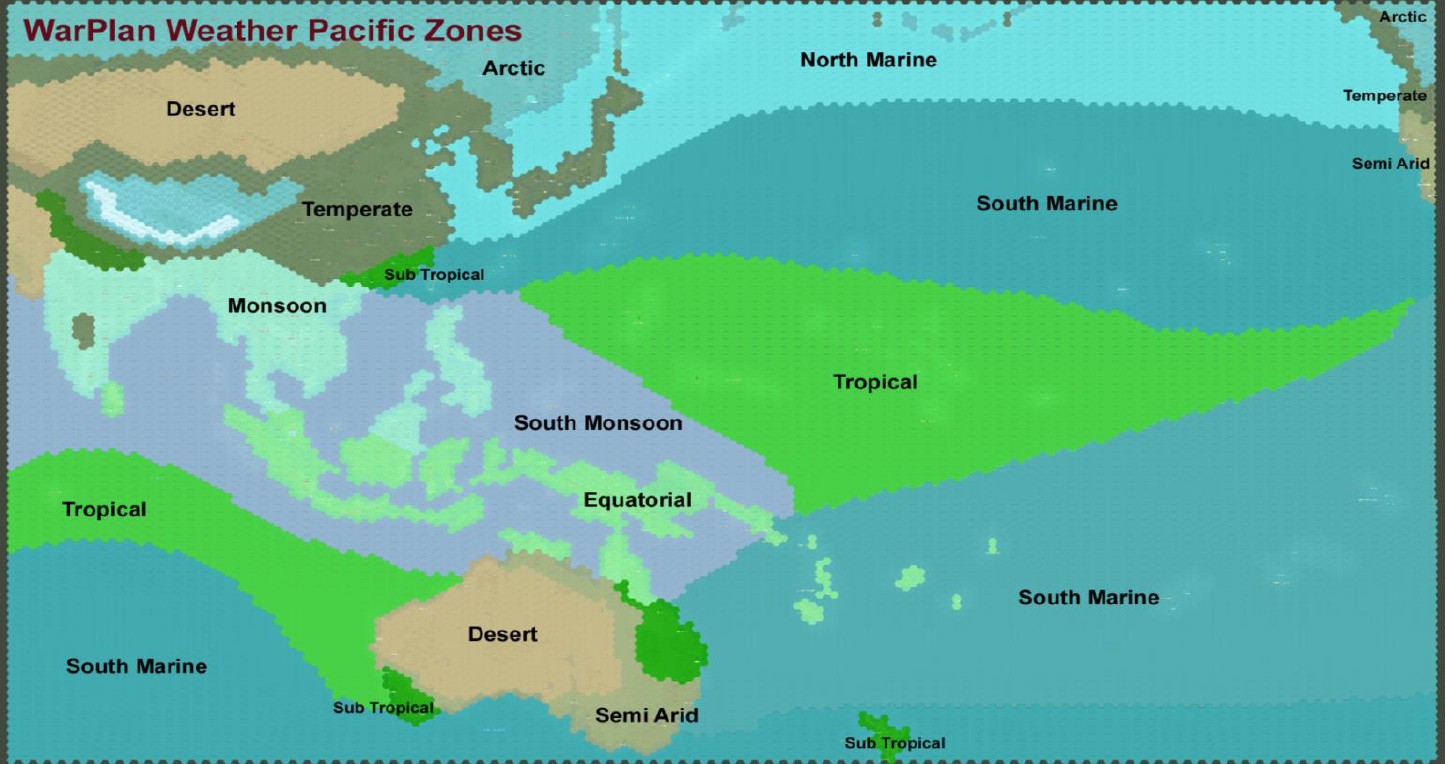
The effect of weather is less outsized on naval combat (although it does have a major impact on the highly randomized chance to find the enemy fleet), especially since it has no movement cost penalties, but much more importantly, the new game’s new weather zones have much less absurd weather probabilities, with the “Equitorial” weather region being a spread of 70% chance for clear weather in the summer to 40% during the autumn months. It at least is a random chance, rather than a guarantee you will never see the sun for whole seasons of the year.
Manual
First, the positive: Since I criticized the last game’s manual (which is a .pdf) for not having chapter markers/bookmarks, I can happily say that WarPlan Pacific now has them. They’re especially appreciated this time around personally, since most of the manual is basically copied over from the last game, and it means I can skip to checking what has actually changed in specific areas.
The problem is not enough of the manual changed with the game. By which I mean that much of the manual is not updated for the new game. I’m not talking just about many of the examples still talking about Italian units rather than Japanese ones. The problem is, for example, where in the original WarPlan, there were no destroyer units, there were just escort units representing broadly everything that could fight front-line battles smaller than a heavy cruiser. Now, there are destroyer units (although they are more like “torpedo squadrons”, formations of destroyers led by light cruisers, not individual ships), while escort units still exist now as smaller craft like corvettes and destroyer escorts, however most of the manual’s charts do not have a line for destroyer units. This creates a serious doubt in my mind when I see any part of the manual that looks the same as the original game’s manual – is it the same because the rules are the same, or is it the same because the developer just forgot to update this part of the manual?
A real example of this occurred with the thing I pointed out as an out-of-date piece of information in the manual in the original WarPlan. Originally, the game had allowed you to attack submarines with carriers. This was later changed in an update to make the u-boats slightly less easy to annihilate, but the .pdf manual was not updated to reflect this. The same passage was still in the WarPlan Pacific manual. I just assumed it was an oversight. Nope! Japanese carriers sank my submarines on turn one while they were clearly out in open water! OK, I guess the manual had the old line still in it because the game engine went back to the older rule allowing carrier attacks on submarines! However, the doubt is still there, I find places where the manual isn’t updated to the new rules, and so when I see rules that look the same, I’m never sure if that’s because there’s been no change, or just no change in the manual.
Another item of note is that the Lend-Lease pathway along the Burma Road, by which the US and UK sent supplies to Nationalist China to resist the IJA advance is something that is only described in a .pdf that comes with the game, but not marked on the game map, itself.
Interface
Once again, I find the interface one of the weakest parts of the WarPlan franchise.
The game is poor about offering user interface options, including still having no way to rebind keyboard keys. Once again I have to state, there is no excuse for a PC game not having full keyboard control rebinding. This is also a game which has many controls that are in ergonomically nonsensical positions. This is a game which absolutely requires using the mouse, so therefore all keys should be within reach of the left hand home keys, but some of the most useful commands are still assigned to keys like “m” being the button to change whether aircraft will support land attacks or not. Beyond that, many of the most useful toggles or buttons in the game have no hotkey assigned to them at all, making for a lot of unnecessary micromanagement shifting back and forth with the mouse in a game that tries to sell itself on reducing that kind of pointless busywork.

Beyond that, however, the game also suffers from a serious opacity problem. You can lose whole stacks of units and not even know they were destroyed in this game if you aren’t paying attention. The game makes which stacks of enemies participated in what battles frequently confusing, which only accentuates the problems with the game being very unclear about how most of it even works. Submarines seem basically useless and die in a single battle. What am I doing wrong? Who knows, the game won’t tell me. Aircraft are basically incapable of dealing damage to land targets. Many things about how the game works are only told to you in the manual, which you can’t trust, and is even then very incomplete. If you have trouble understanding why something isn’t working in this game, you basically have to go to the forums to ask for help, because the game won’t help you. If you for some reason (such as being a young player who wants to play on their father’s computer, where your father owns wargames, the way I got my start in gaming) have no idea how historic World War II naval formations were put together or how the overall course of the war went because you aren’t a history buff, this game makes little effort to accommodate those who aren’t already deep into the war history buff or wargaming niche.
I was told in the forums by the developer during the last game that I was underestimating the depth of the strategy in the game, but as I said at the time, if players aren’t given a chance to understand what they actually control, that’s on the developer for taking the chance to develop a coherent strategy away from the player by taking away the information they need to make informed decisions. I again have to repeat I was flabbergasted by the fact that the developer apparently told one of the other reviewers on Steam that the game’s mechanics are not told to the player to prevent “min-maxing”. This is a strategy game. Strategies need information. “Min-maxing” is strategy. Any strategist should be trying to maximize their effectiveness.
Graphics and Sound
There is an alternate version of tokens and some mods that change the graphics for the tokens if you wanted to see the silhouette of specific ship types, but by and large, what you see is what you’re going to get in terms of graphics. Graphics options largely amount to fullscreen or different window sizes. A text size option is the most notable user interface option, which can allow particularly large resolutions to not have extraordinarily tiny font.
Sounds-wise, sound effects are as far as I can tell entirely the same as the original WarPlan, which isn’t any real surprise, since I doubt Japanese boots marching sound appreciably different from German ones. Being as you are taking a view of hexes on a map on a table, it would honestly be jarring if they were actually lifelike or brought about verisimilitude, so all I can say is that I wish there were perhaps more variety or a way to have the common sound effects trigger less often. There’s far too much “boots march” being played in rapid succession.
Music-wise, if the last game had a soundtrack that sounded like it was going for your generic patriotic World War 2 movie soundtrack, this one was apparently left filling in the roster with all the Asian war music the artist had around that wasn’t in the last game. With only about a half-dozen tracks total, which notably play in order every time, you’ll quickly notice that all but the last one is obviously the Japan/China/Vietnam war music, with a single bombastic American track to round out. The total playtime isn’t enough to even cover one turn, so this is another game I wound up just muting and playing my own music over.
Bugs
Bugs were mostly eliminated between games, but oddly, I did find one notable one in the China campaign that hypothetically should be the most stable, as it is the most like the original WarPlan. Possibly because of something to do with the partisans cutting off railroads, I would find nearly my whole army cut off from supply… in spite of clearly being in supply on the map, even if not in full 9 supply.
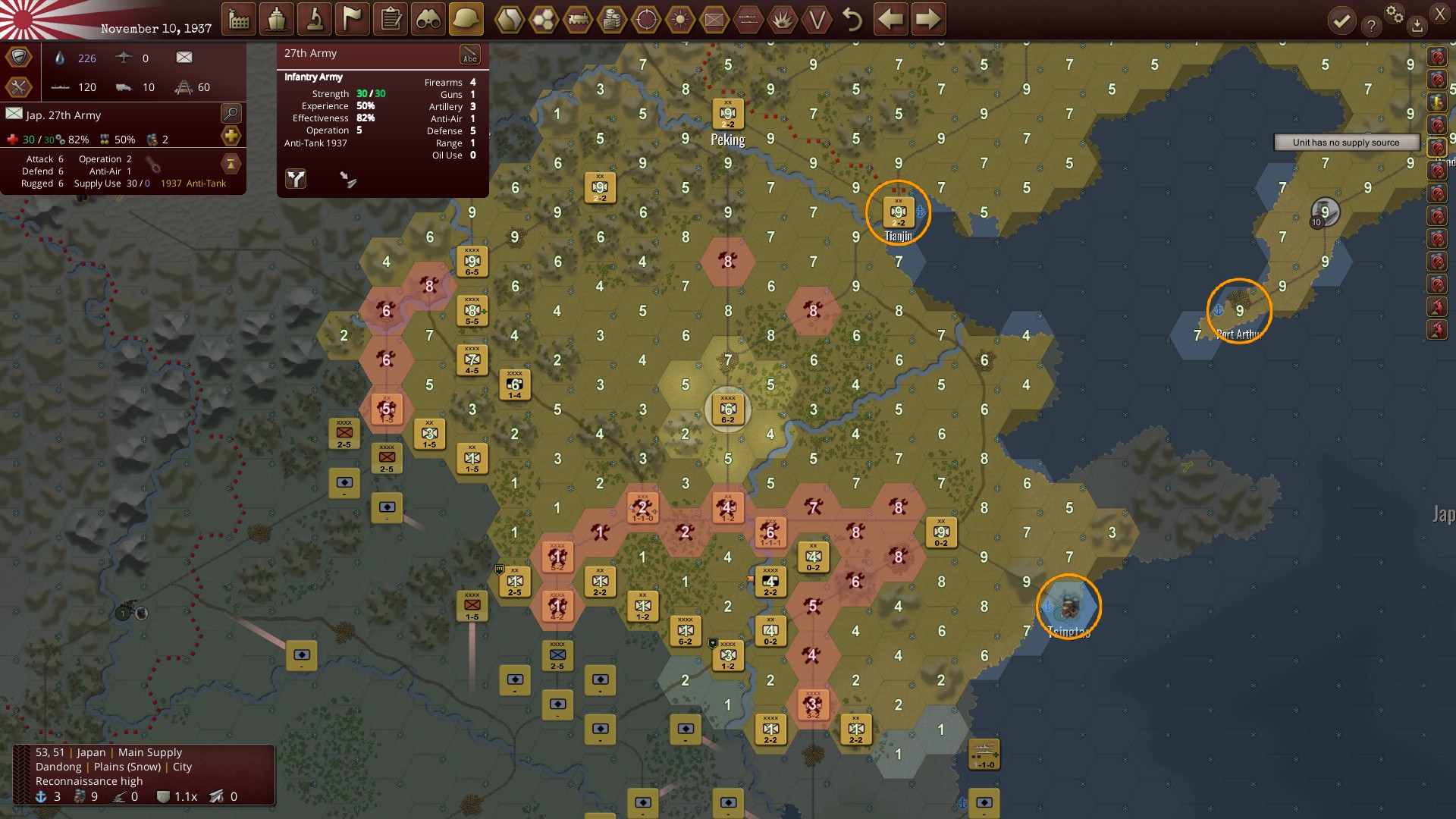
Reloading the autosave (and having the partisans attack different sections of rail) would still break rail connections, but I wouldn’t have my entire army be declared out of supply.
I also mentioned this above, but the maps are broken in places. The “beach” tiles do not always connect to the hexes that the map clearly shows them connected to, in some cases not being connected to anything at all! These beaches are connected to no land, supply, or means of transporting them back, so there’s nothing you can do but eat the losses and disband the unit or savescum and try to land somewhere that isn’t a secret trap beach…
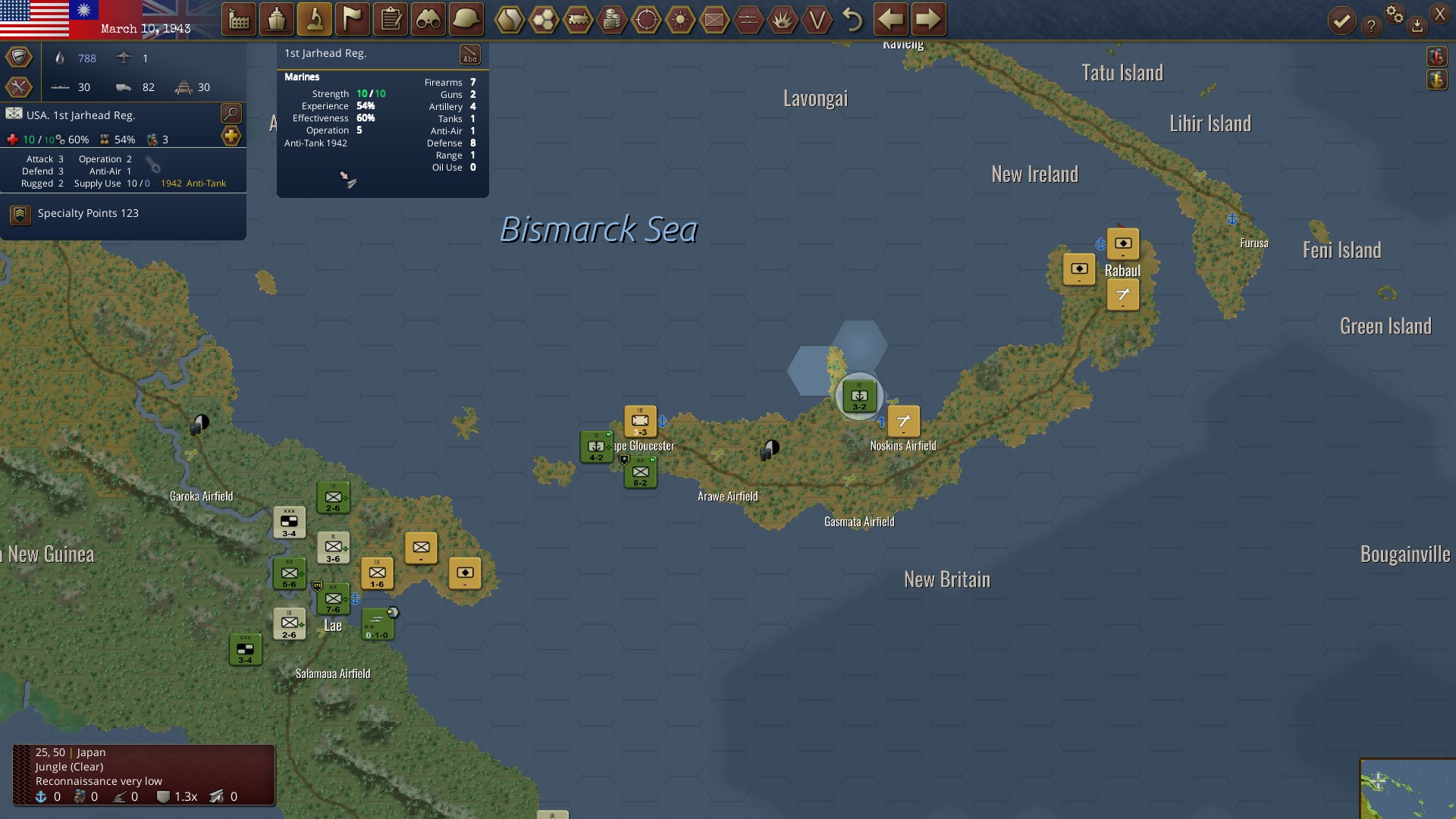
Another minor but persistently annoying issue is that the game launcher triggers User Account Control on Windows every time I try to launch it. This sort of thing tends to be something like referencing a Windows registry file that doesn’t exist because of some developer oversight. It’s no huge deal, but it’s been 12 years since Windows 7. Commercial games should not be triggering UAC every time you launch them in 2021.
Verdict
While it is essentially the same game as the original WarPlan, the difference in theaters and the shift to a more naval campaign winds up making this a game that I, at least, found more interesting. That said, naval losses are also much more difficult to replace, making a couple decisive battles totally overturn a campaign. A rigid AI also means this is much more a game you will want to play with a human opponent.
Compared to other strategy franchises, this is a game that is much less micromanagement-heavy, and suitable for multiplayer games you aren’t interested in spending all year playing while still being far-reaching enough to feel like a realistic simulation of the whole war.

